For this month’s Garden Bloggers Bloom Day I have some closeup photos of some of what’s blooming in the garden. I’ve done a couple posts on using backgrounds behind plants (Background check / One way to photogrpah a tree). Inspired, all but one of these shots uses a white sheet of matboard placed behind the plants. Each color of background presents a different end result. Using white accentuates dark flowers and stems, and some of these photos are a busy network of dark lines against the light background.
There are some newcomers just coming into bloom, but many plants have been in bloom for several months. When life gives you more of the same flowers…well, I was thinking I’d try to photograph them a little differently.
I suspect the neighbors think I’m odd enough taking pictures of everything in the garden, and I thought it’d be extra-distressing if I were to be walking around the garden with a big white board as well as the camera. As a result all of these are from the quiet privacy of the back yard, with the exception of the one plant without a white background.
Purple coneflower, Echinacea purpurea.
Lion’s tail, Leonotis leonorus; Desert mallow, Sphaeralcea
ambigua.
Peruvian daffodil, Hymenocallis festalis; Freeway daisy, Osteospermum sp.
Verbena bonariensis; Juncus patens (with fallen leaf caught in the plant).
Some salvias:
Salvia nemerosa ‘Snow Hills’; Ivy-leaved sage (Salvia cacaliaefolia).
On the left is Andean sage (Salvia discolor with its almost black flowers set in light green calyces; on the right is Salvia microphylla ‘Hot Lips.’
Some California buckwheats:
Flat-topped buckwheat (Eriogonum fasciculatum)
San Miguel Island buckwheat (Eriogonum grande var. rubescens)
St. Catherine’s lace (Eriogonum giganteum)
Butterfly bush (Clero- dendrum ugan- dense); seed pod of whitetop pitcher plant (Sarracenia leucophylla).
Pink and white double bougainvillea (unknown variety); Agastache aurantiaca ‘Apricot Sprite.’
Pink double bougainvillea (another unknown variety); toloache (Datura wrightii).
Thanks again the Carol of May Dreams Gardens for hosting Garden Bloggers Bloom Day. It’s a terrific way to build community among garden bloggers wanting to share the flowers in their gardens. Check out this month’s offerings!

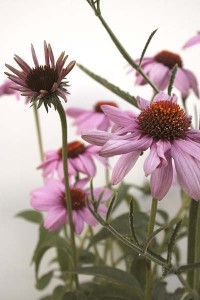
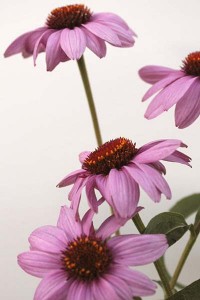
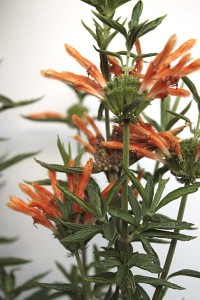
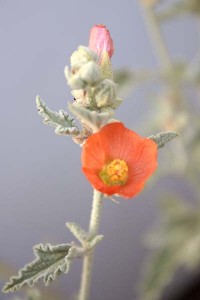
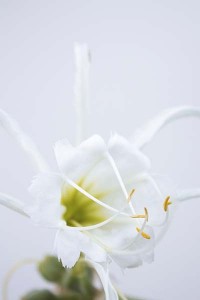
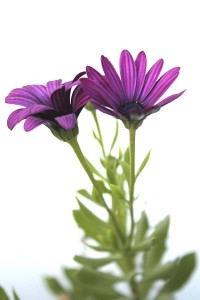



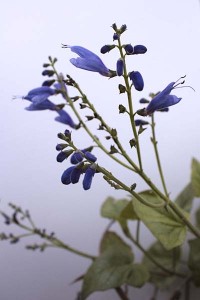
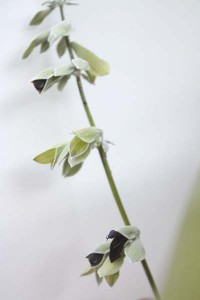

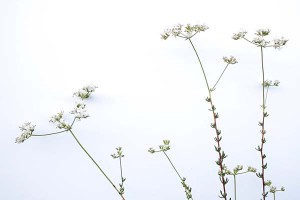
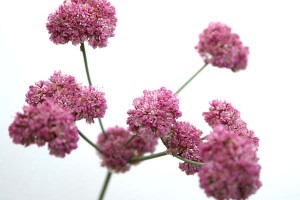
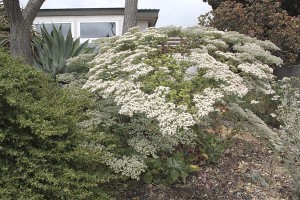
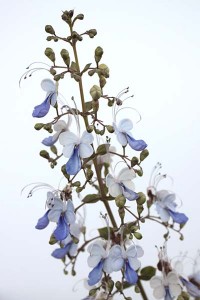
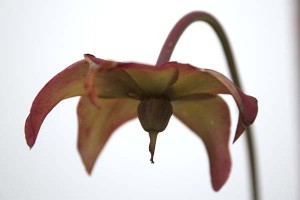

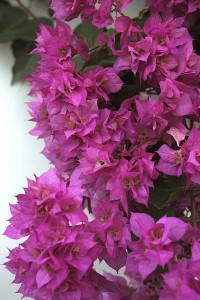
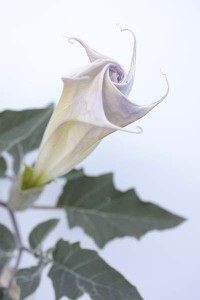
You are one of the night-owls, I one of the early birds 🙂
Your Peruvian daffodil is my Spider Lily. Just as well we have botanical names.
A lovely, lovely page of delicate flower pictures.
Another night owl here. Love the Leonotis & the St. Catherine’s Lace. I think my neighbors are a little suspicious of me too! But then…they might photograph too with so many blooms! havn’t tried the board trick yet, then they would really think I am loony!
Jim,
You’ve made some wonderfully intimate pictures with this technique for camouflaging the camouflage.
I don’t know if you originally had it in mind, but the title of your blog sure fits this theme!
Interesting idea to use a whiteboard behind the flowers. It certainly places the focus right on the flower and takes away any background ‘noise’. I love the intensity of color of the double pink bougainvillea.
I do enjoy the St. Catherine’s Lace photo though too. It’s always nice to see plants in the garden and get a sense of what’s happening around them.
Happy Bloom Day!
The white background makes a big difference. The flowers sure do pop. Poor neighbors. I have the same issue here. They can’t figure out what is so interesting about flowers and plants.
Neat effect! The flowers look as if they are printed on white paper.
That datura pic is fantastic.
The white background does have interesting effects. I wonder whether the white flowers would work even better with backgrounds of some other color.
I’m impressed by how many of your plants are blooming so far into summer. And I need to get myself a Sphaeralcea one of these days.
Your pictures are gorgeous – what an inspiration! I love the datura bud and the Juncus patens.
I love to see echinacea when the pink petals are perfect….so often here they are brown spotted almost immediately. The big white poster is a great idea! gail
Very cool pictures! And very fun plants!
Happy bloom day
Thanks, Jo. I’m glad we have the latin names to sort out what the common names don’t help us with.
Susie, yes, the ever-present uncomprehending neighbors…
George, no, I wasn’t thinking about the blog name when I took these but I definitely see your point! So often the little flowers get…well, lost in the landscape.
Debbie, I worry that this technique might make things look too much like a plant catalog and not a real garden. It’s nice to see the plants, but it’s also nice to see how they interact in a garden.
Tina, keep working on your neighbors. You’ve got plenty of interesting things that should bring them around.
Pam, a lot of these are plants people know pretty well, so it’s fun to play with different ways to make the photos interesting.
Brad, as nice as the daturas are in full flower, I really dig how their buds have the little hooks on the petals.
Gayle, a different color would give more contrast, for sure. The whole photographic notion of a “high-key” picture, where just about everything is near-white is one I really like. I wonder if Sphaeralcea from Northern California, munroana would do well for you. Some people like it lots better than ambigua.
Barbara, thank you. Even with the bright flowers from beyond, the natives still seem to be holding their own pretty well…
Gail, my echinaceas haven’t been open long. I’m sure they’ll start to spot and turn color before long. It might help that it doesn’t get warm AND humid here very often.
Town Mouse, happy bloom day to you too. I’ll be over to check you bloom post in a couple minutes…
Interesting collection. I’m impressed at how good the datura looks against a white background and not even opened yet. I didn’t know that common name for it, or a couple of others. Freeway daisy? I can see how that got its name.
As far as I know, that common name is only for that particular datura – the datura/brugmansia world is a complicated and beautiful thing. I have a little bit of sickness about photographing datura, and those little hooks on the buds – and the way the buds unfurl – and the incredible depths and highs the open flowers have- I’d hate to admit how much of my computer space is dedicated to them.
I hadn’t seen St. Catherine’s lace before, I’m joining the crowd here of those who like it. The osteospermum and pitcher plant particularly caught my eye.
For me, this kind of photography worked better with some of the plants than others. I do find myself a bit disconcerted at losing the context of a plant; on the other hand, I think it’s interesting to play with different ideas. Even if you don’t wind up using the whiteboard much, something about it may give you ideas that you want to use.
I just bought a Sphaeralcea munroana today, so I guess I’ll find out!
On second thought . . . no I didn’t! I was just looking at pictures and descriptions of Sphaeralcea munroana on the Internet and noticed some odd differences between my plant (and the others at the nursery) and what is supposedly typical for Sphaeralcea munroana. Then I saw the reference on http://www.wildscaping.com/plants/plantprofiles/Sphaeralcea_munroana.htm to some nurseries having sold a South American plant, Sphaeralcea philippiana, mislabeled as S. munroana. I compared my plant with the photographs of each, and determined that my plant is definitely Sphaeralcea philippiana rather than S. munroana. And it came from a native plant nursery!